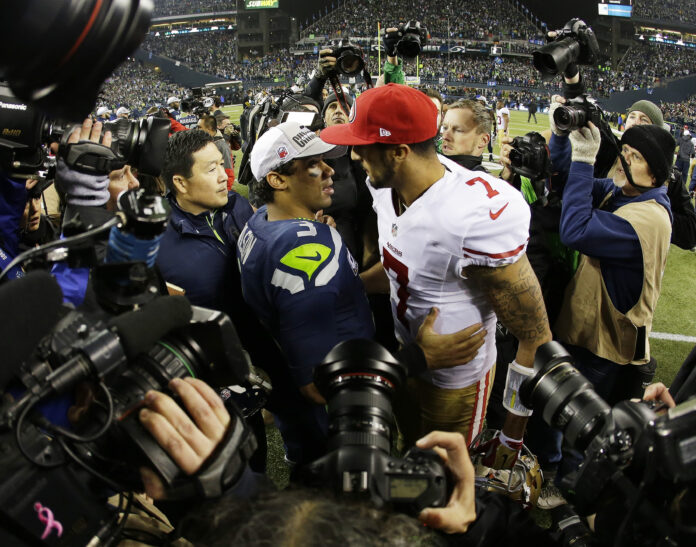Football, often hailed as the ultimate team sport where every player holds significance, still places the quarterback position on a lofty pedestal. The quarterback, viewed as supremely more valuable, garners considerable attention.
From a former quarterback’s perspective, the sentiment finds agreement. Yet, the intriguing question arises: What if a general manager and head coach dared to challenge the prevailing NFL model?
At the very least, they should consider discussing and scrutinizing this notion within their strategic “war rooms.” The evolving landscape transforms how we perceive the game, requiring further examination.
Russell Wilson swiftly ascends to an elite quarterback; many already regard him as such.
Drafted in the third round of the 2012 draft, he presently stands three years into his four-year rookie contract. NFL teams prefer not to let their star players approach the final year of their deals, as it weakens their bargaining position and jeopardizes their vital assets.
Consequently, it’s widely expected that Wilson will secure a substantial contract this offseason, potentially in the ballpark of $20 million per year for multiple seasons.
Such a commitment represents a significant portion of Seattle’s salary cap, and preparations are quietly underway.
These preliminary considerations, often shrouded from public view, are in full swing as Seattle emerges from its bye-week. It’s a moment for assessing the roster’s present and prospects—an opportunity for reevaluation.
But what if teams chose a path divergent from paying the exorbitant price to retain their franchise quarterback? What if Seattle allowed Wilson to depart and embarked on a search for his replacement?
Such a decision might invite widespread criticism, with calls for GM John Schneider’s dismissal and the removal of Pete Carroll. Could it be, though, that this unconventional move is the right course of action?
Before any pitchforks are raised, it’s crucial to acknowledge that the author is a fervent Russell Wilson admirer.
He perceives Wilson as one of the most dynamic young quarterbacks in the league, a rare success both on and off the field. Wilson possesses a remarkable degree of accuracy and excels as a pocket passer, deftly progressing through his options.
He stands as one of the premier playmakers among quarterbacks in the league, all the while exhibiting a remarkable penchant for protecting the football. This exceptional combination of intelligence, athleticism, accuracy, poise, leadership, and decision-making skills is undeniable.
Moreover, Wilson comes at an exceptionally modest cost, even by NFL standards. His salary is remarkably frugal. This season, Wilson is set to earn a base salary of $662,000.
In stark contrast, marquee quarterbacks such as Peyton Manning, Tom Brady, Aaron Rodgers, Drew Brees, Joe Flacco, and Matt Ryan will collectively account for approximately $20 million against their respective teams’ salary caps.
This represents roughly 15% of their teams’ financial resources invested in a single position.
However, contemplate the prospect of a team automatically having a salary cap figure of $20 million larger than the rest of the league.
Such a team would likely be fortified across numerous positions, thanks to the surplus financial resources enabling the acquisition of high-priced free agents and the retention of key players.
This depth would empower them to overwhelm opponents and replace injured players with seasoned veterans rather than undrafted rookies, a distinct advantage few teams have enjoyed in recent years.
As the 2013 NFL season drew to a close, a consensus among fans and players emerged, declaring the Seattle Seahawks and the San Francisco 49ers as the league’s premier teams.
Following Seattle’s resounding victory over Denver in the Super Bowl, the prevailing sentiment was that the actual championship had unfolded two weeks earlier during the NFC Championship game.
In this climactic showdown, Russell Wilson and Colin Kaepernick engaged in a head-to-head battle that hung in the balance until the final moments.
Both quarterbacks showcased their abilities, operating under rookie contracts that paid them just shy of $1 million, and both displayed their versatility on the field.
In the lead-up to the 2013 season, Seattle and San Francisco distinguished themselves as two of the most active teams in the free agency market.
It appeared that nearly every available free agent was considered a potential addition to their rosters, and many of them ultimately donned the Seahawks’ or 49ers’ uniforms.
This frenzy of acquisitions was fueled by the understanding that they had a limited window to invest significantly in fortifying the rest of their teams.
At some juncture, the moment would arrive for their quarterbacks to command substantial contracts, necessitating a more restrained approach to financial expenditure.
If teams are constantly looking for an edge and researching the best ways to win a championship, they wouldn’t be thorough if they didn’t discuss the “non-franchise” quarterback model
San Francisco, in the recent offseason, made a notable shift by signing Colin Kaepernick to a new contract that sees him earn approximately $16 million this season.
Although the 49ers are expected to remain competitive late into December, their 2-2 start to the season underscores the financial constraints they now face.
Their less active stance in free agency, coupled with the contract negotiations of players like guard Alex Boone and tight end Vernon Davis, has tightened their purse strings. While the impact may not be immediately apparent, it will inevitably affect their depth as the season progresses.
So, what’s the alternative if a team does not offer their promising Pro Bowl quarterback a substantial extension? The solution, in the author’s view, lies in redefining the NFL’s salary cap business model.
For most teams, the relentless pursuit of a franchise quarterback remains a top priority. They comb through the college ranks and even consider talented NFL backups.
The quest keeps general managers awake at night and consumes valuable time and resources. Once they identify the right player, often after several trials and errors, they commit to that massive contract extension.
But why follow this well-trodden path?
It’s widely acknowledged that having an elite quarterback provides the best chance of success.
Nevertheless, we recently witnessed the two best NFL teams competing with quarterbacks who weren’t first-round picks and didn’t fit the prototypical pocket passer mold. Strangely, few seem inclined to replicate this model. If they did, it might resemble the following approach:
Firstly, teams should make annual investments in quarterbacks through the draft. Thanks to the new Collective Bargaining Agreement (CBA) and lower contracts for first-rounders, they can select players without a massive cap hit.
The emphasis should be on finding players with unique skill sets, those who deviate from the standard NFL quarterback mold. Seek quarterbacks around whom you can construct a distinctive offense that poses challenges for opposing defenses.
Great runners are welcome, and concerns about their durability over 12 years can be set aside. Shorter quarterbacks are acceptable, as having a cannon for an arm takes a backseat to accuracy.
Competitiveness and toughness are essential, given that games may be won through old-school, gritty play.
Even if a gem like Russell Wilson is discovered, it’s prudent to draft another quarterback the following year and the year after. When the starter enters his fourth year, the backups will be prepared to step in.
Having contingencies in case of injury becomes a valuable asset. It’s not out of the question to find a quarterback who can contribute on special teams, perhaps doubling as a kickoff tackler.
However, the paramount advantage of this strategy is the surplus salary cap space. The $20 million that might have been allocated to a marquee quarterback can be redirected to bolster the overall roster.
This might involve shoring up an aging offensive line, adding depth at tight end and wide receiver, or fortifying the defense.
Contracts for key players like Richard Sherman and Earl Thomas can be extended, and the defensive line can be enhanced to apply relentless pressure on opposing offenses. The possibilities are numerous.
The underlying point of this thought exercise is to challenge the conventional structure of the NFL’s player compensation model. Just as the value of running backs has steadily diminished in recent years, it begs the question: could the value of quarterbacks undergo a similar transformation?
It’s virtually sure that Seattle will award Russell Wilson the substantial contract he deserves, and in all likelihood, it’s a prudent move.
Yet, for teams relentlessly searching for a competitive edge and exploring the most effective methods to win championships, ignoring the “non-franchise” quarterback model would be an oversight.
While few might be willing to take the risk, the concept isn’t as far-fetched as it may seem and merits consideration.

